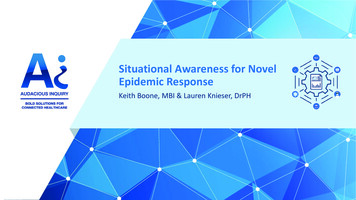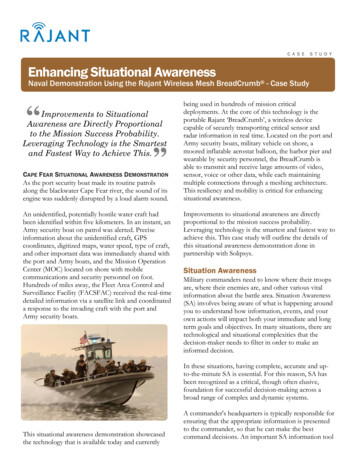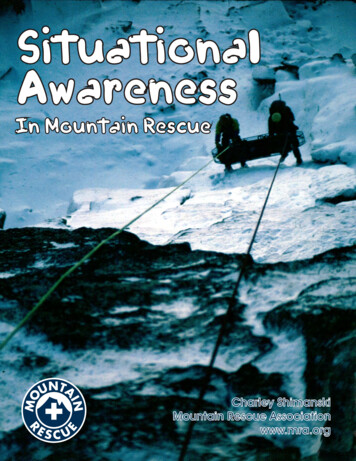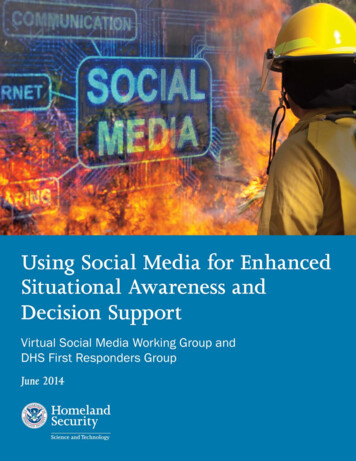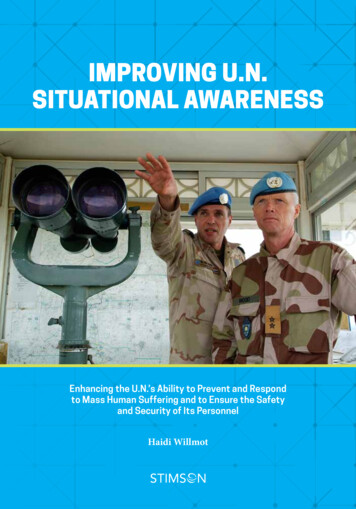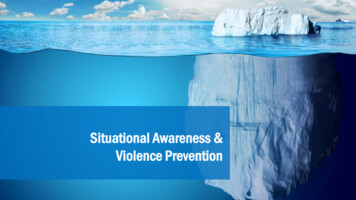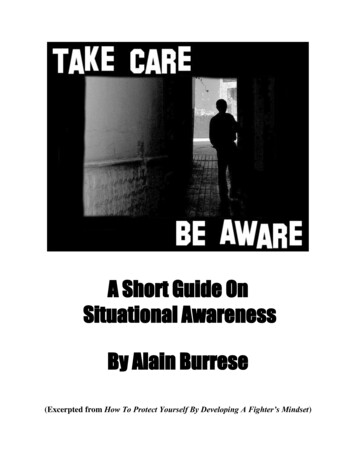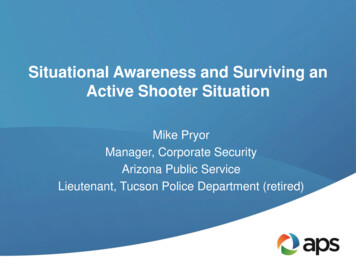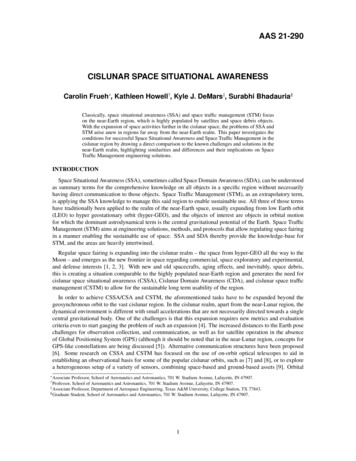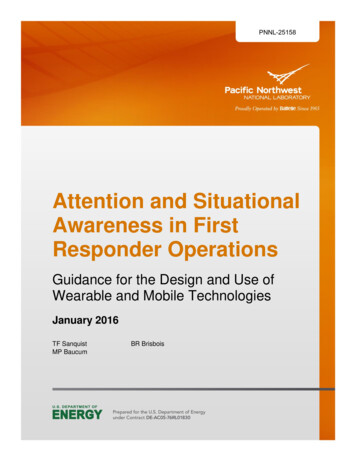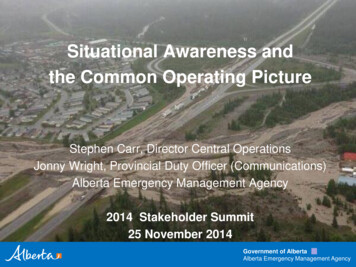
Transcription
Situational Awareness andthe Common Operating PictureStephen Carr, Director Central OperationsJonny Wright, Provincial Duty Officer (Communications)Alberta Emergency Management Agency2014 Stakeholder Summit25 November 2014Government of AlbertaAlberta Emergency Management Agency
Presenters - Context Steve Carr– With AEMA Operations since the fall of 2011– Involved in every POC elevation as POC Director– 22 years service with the Canadian Armed Forces (PPCLI) Jonny Wright– With AEMA POC since spring 2013– Significant experience with building daily media scans (assessmentand analysis) for senior GOA officials– 20 years experience in shared situational awareness roles BLUF – we don’t have all the answers. What we offer isbased on past experience, ‘informed’ opinion and personalperceptions a bit of a themeGovernment of AlbertaAlberta Emergency Management Agency
Outline Some terminology & definitions Theory*** Where we were in 2013 (AEMA / GOA POC) Where we are now in 2014 Where we are going 2015 Conclusion / Discussion ***Significant reference: Dr. Robert MacFarlane and Mark Leigh, InformationManagement and Shared Situational Awareness, Emergency PlanningCollege Occasional Paper #12, September 2014Government of AlbertaAlberta Emergency Management Agency
Terminology & Definitions Emergency – An event that requires prompt coordinationof action or special regulation of persons or property toprotect the safety, health or welfare of people or to limitdamage to property (EMA 2013) Emergency Management – The management ofemergencies concerning all hazards, including activitiesand risk management measures related to preventionand mitigation, preparedness, response and recovery(GEMR 2007)Government of AlbertaAlberta Emergency Management Agency
Terminology & Definitions Crisis - A time of intense difficulty or danger. An eventthat is, or is expected to lead to, an unstable anddangerous situation affecting an individual, group,community, or whole society. Characteristics include:–––––––SuddenUnexpected and/or ing and/or competing objectivesGovernment of AlbertaAlberta Emergency Management Agency
Terminology & Definitions Situational Awareness – Knowing what has and isoccurring within your environment and understanding theimplications of these events and the potential outcomesassociated with them. (human element - intellectual) Shared Situational Awareness - The common (shared)knowledge and understanding held by those involved in asituation that should support unity of purpose and effort,and in turn enable an effective collective response.Government of AlbertaAlberta Emergency Management Agency
Terminology & Definitions Common Operating Picture – An overview of a situationthat is created by assessing and fusing information frommultiple sensors or sources to support timely andeffective decision-making. (a product of technology)SA & SSA COPGovernment of AlbertaAlberta Emergency Management Agency
Situational Awareness Understanding of what has happened, what is happeningand what may happen yet What are and may be the implications of the event? What are the second and third order effects? (collateraland/or cascading impacts) Direction and action taken and to be taken in the futureGovernment of AlbertaAlberta Emergency Management Agency
Situational Awareness“There are known knowns. These are things we know thatwe know.There are known unknowns. That is to say, there arethings that we know we don’t know.But there are also unknown unknowns. There are thingswe don’t know we don’t know.”Donald RumsfeldGovernment of AlbertaAlberta Emergency Management Agency
Situational Awareness Largely about information management– Made significantly more difficult based on the inherent uncertaintythat exists during a crisis, further compounded by organizationalcomplexities (conflicting objectives)IM IT Making sense out of noise (data)– What matters depends on your viewpoint– Forest for the trees– PrioritizationMore data More informationGovernment of AlbertaAlberta Emergency Management Agency
Source: MacFarlane & Leigh (2014)Situational AwarenessThe Evidence Gap in Crisis Management – The period of greatest uncertaintyGovernment of AlbertaAlberta Emergency Management Agency
Situational Awareness Three levels of SA:1. Perception – building a complete picture of what is occurring atthe event-level. Perceiving the critical factors in theenvironment. Purely reactive.2. Comprehension – developing an understanding of the event,what the critical factors mean and how they potentially impactthe decision-maker’s objectives. Largely reactive, commencingshift to proactive.3. Projection – the ability to construct a sense of what might occurin the future and what the implications of this could be. This canbe done through modelling, scenarios or simulations. Proactive.Government of AlbertaAlberta Emergency Management Agency
Shared Situational Awareness The conceptual objective of SSA is for all decision-makersand stakeholders to see the same situation in the samefashion The reality is that while the information may be presentedin a single fashion, it may still be viewed, interpreted orperceived differently by recipients––––Individual needsSelect organizational or group requirementsPast experienceDoctrine, SOPs, language etc All can conspire to reduce the ‘area’ of common interest Not all information needs to be sharedGovernment of AlbertaAlberta Emergency Management Agency
Shared Situational Awareness This does not negate the value of working towards SSA.It simply means actors need to understand those areaswhere common or shared objectives are found and focusthe effort on these.POCXEOC‘A’ECC‘B’Build this SSA to focusdecision-makers as theymanage complex sharedproblems. Seek to reduceduplication of effort andachieve optimal ‘efficiencyof action’.Government of AlbertaAlberta Emergency Management Agency
Common Operating Picture Variety of ways to contribute to or build SSA––––––Use of common IMS (doctrine, TTPs)Clarity of languageSetting an operational rhythmRegular meetings (face to face, video and telecon)ReportingBuilding a COP The COP is a ‘product’ Conveys geographic, spatial, textual, graphical data Whether it is static or interactive/real-time information, itserves as a ‘point of reference’ for achieving SSAGovernment of AlbertaAlberta Emergency Management Agency
Hazardous Materials Release and Fire – City ‘X’ (as at 1500hrs 26 Aug 15)Live Feed***POC Orientation Brief to all staffat 1515hrsMainwillEventcommenceLog1330hrs26 AugInitial report received from CIC – unknownhazardous material release at industrial fireat 10026 – 46 Ave1338hrs26 AugFO contacted and directed to estb commswith City ‘X’ EMO1354hrs26 AugFO advises that City ‘X’ EOC has beenactivated. Fire on-site. Material TBC butcordon is being estb at 500m. Evacs likelywithin this area. Shelter in placerecommended outside cordon.1400hrs26 AugPOC Alert issued and POC elevated to L31403hrs26 Aug1425hrs26 AugCity ‘X’ issues CRITICAL ALERT on AEAGovernmentofissuedAlbertaEOCSITREP 001(see eventAlbertaEmergencyManagementAgencydocument site)
Where We Were (2013) Geographic area of 55,000 km2 Total population 1.6 million Urban and rural areas impacted Federal and provincial jurisdictionsaffected: -Federal national parks and threeFirst Nations-Local authorities and provinciallymanaged improvement districtsimpactedEvent unfolded in two stages:-Initially in the West near themountains-Two days later the river systemspeaked in the EastPOC simultaneously coordinatingmitigation, preparation, response, andstabilization operationsGovernment of AlbertaAlberta Emergency Management Agency
Where We Were (2013) POC elevated to Level 4 for 26 days (20 June - 15 July)More than 125,000 persons evacuatedApproximately 14,500 homes impacted1,100 small businesses (up to 20 employees) impactedAlmost 2,700 Albertans displaced and requiringaccommodations assistance GOA Request for Assistance to GOC results in thedeployment of 2,200 Canadian Armed Forces personnel Immense infrastructure damage (over 900kms of roadrepairs required) Estimate 5 billion dollars in damage – 1.7 billion insurable(costliest disaster in Canadian history)Government of AlbertaAlberta Emergency Management Agency
Where We Were (2013)30 States of Local Emergency were declared bythe following local authorities: City of CalgaryCity of LethbridgeCity of Medicine HatCity of Red DeerMD of BighornClearwater CountyMunicipality of Crowsnest PassCypress CountyMD of FoothillsID of KananaskisMountain View CountyMD of RanchlandsRocky View CountyMD of Willow CreekVulcan County One Provincial State ofEmergency for the Townof High RiverTown of BanffTown of Black DiamondTown of CanmoreTown of CochraneTown of DrumhellerTown of Fort MacleodTown of High RiverTown of OkotoksTown of Pincher CreekTown of RedcliffTown of SundreTown of Turner ValleySiksika First NationStoney First NationTsuu T’ina NationGovernment of AlbertaAlberta Emergency Management Agency
Where We Were (2013) Fighting for a picture as of 0230hrs 20 June– A 24-36hr ‘Evidence Gap’– Limited ability to achieve ‘boots on ground’ (numbers, space andtime, access)– Prioritization of information (overload)– Uncertainty– Lack of agility in SOPs (comms and reporting protocols)– Multiple locations with different objectives (near concurrent activityacross four pillars)– Operational versus tactical– Action versus Coordination– Challenged by communications priorities (up versus down)– Lack of IT/GIS interoperability– Time lag in COP as a productGovernment of AlbertaAlberta Emergency Management Agency
Where We Were (2013) Observations – Building better SSA– Requirement for more robust communications protocols Internal to GOAExternal to PS stakeholdersPlain, clear languageAffected and unaffectedMultiple means and methods– Shortfalls in our ability to directly support affected communities Field Officer presence Incident Management Teams– COP as a product StaticTime-lagIncompleteNot sharedGovernment of AlbertaAlberta Emergency Management Agency
Where We Are (2014) Observations – Building better SSA– Requirement for more robust communications protocols Internal to GOAExternal to PS stakeholdersPlain, clear languageAffected and unaffectedMultiple means and methods Ongoing refinement of comms tools Wider dissemination of updates (2014floods) Less rigid reporting lines– Shortfalls in our ability to directly support affected communities Field Officer presence Incident Management Teams Double size of field contingent Encouraging regional IMT development– COP as a product StaticTime-lagIncompleteNot shared Decision taken to identify (RFP) andimplement a new incident managementsystemGovernment of AlbertaAlberta Emergency Management Agency
Where We Are (2014) PSDSI was implemented as an interim POC incidentmanagement solution following the non-delivery of apurpose-built solution in 2010. PSDSI is based on SharePoint 2007 (not supported pastsummer 2015). PSDSI does little to aid in the development of SSA throughthe production of a COP for the GOA or the Public Safetysystem.–––––A logging tool with constrained search capabilitiesRudimentary task routingNo integrated GIS capabilityLimited capacity for data-sharing outside the GOAHighly restricted external access capabilityGovernment of AlbertaAlberta Emergency Management Agency
Where We Are Going (2015 ) AEMA is working to procure an incident managementsolution that supports the generation of a variety ofinformation tools that include, but are not limited to:–––––Operational logs with comprehensive search functionGIS productsSituation and status reportsTask routing, tracking and associated cost capture functionsCommunications and imagery products. Ideally these can be displayed in the POC ordisseminated internally or externally in a fashion thatcreates a COP – a product.Government of AlbertaAlberta Emergency Management Agency
Where We Are Going (2015 )Achievedthroughimproved SAand SSAGovernment of AlbertaAlberta Emergency Management Agency
Where We Are Going (2015 )Spring2015New POCApplicationimplemented &operatingparallel toPSDSISummer2015PSDSIreplaced &ARC GISintegrationFall2015AEMAapplicationintegration orreplacement(EMIS, PSNS,SharePoint)20162017?Intelligencesharing applicationsApplicationextension toCommunityEOCs/ECCsGovernment of AlbertaAlberta Emergency Management Agency
Challenges / Discussion Points Operational (POC) vs tactical (ECC/EOC) needsNot a ‘one size fits all’ exerciseCOTS with configuration vs customization ( )Restricted or tailored viewsEnsuring a two-way portalPrivacy issuesOther?Government of AlbertaAlberta Emergency Management Agency
Conclusion A product can aid but only so far It is about a mindset as much as anything‘Dare to Share’Don Randall, MBEChairman Griffin National ExecutiveGovernment of AlbertaAlberta Emergency Management Agency
Situational Awareness – Knowing what has and is occurring within your environment and understanding the implications of these events and the potential outcomes associated with them. (human element - intellectual) Shared Situational Awareness - The common (shared
